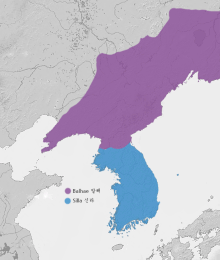North-South States Period
| North–South States Period | |
 |
|
| Hangul | 남북국시대 |
|---|---|
| Hanja | 南北國時代 |
| Revised Romanization | Nambukgukshidae |
| McCune–Reischauer | Nampukkuksitae |
North–South States Period (698–926 CE) is the period in Korean history when Later Silla and Balhae coexisted in the south and north of the peninsula, respectively.
After the unification wars, the Tang Dynasty established territories in the former Goguryeo, and began to administer and establish communities in Baekje. Silla attacked the Chinese in Baekje and northern Korea in 671.
The Tang Dynasty then invaded Silla in 674 but Silla defeated the Tang army in the north. Silla drove the Tang forces out of the peninsula by 676 to achieve unification of most of the Three Kingdoms.
Later Silla was a golden age of art and culture, and Buddhism became a large part of Silla culture. Buddhist monasteries such as the Bulguksa are examples of advanced Korean architecture and Buddhist influence. State-sponsored art and architecture from this period include Hwangnyongsa Temple, Bunhwangsa Temple, and Seokguram Grotto, a World Heritage Site.
Later Silla carried on the maritime prowess of Baekje, which acted like the Phoenicia of medieval East Asia, and during the 8th and 9th centuries dominated the seas of East Asia and the trade between China, Korea and Japan, most notably during the time of Jang Bogo; in addition, Silla people made overseas communities in China on the Shandong Peninsula and the mouth of the Yangtze River. Later Silla was a prosperous and wealthy country, and its metropolitan capital of Gyeongju was the fourth largest city in the world.
Buddhism flourished during this time, and many Korean Buddhists gained great fame among Chinese Buddhists and contributed to Chinese Buddhism, including: Woncheuk, Wonhyo, Uisang, Musang, and Kim Gyo-gak, a Silla prince whose influence made Mount Jiuhua one of the Four Sacred Mountains of Chinese Buddhism.
...
Wikipedia
